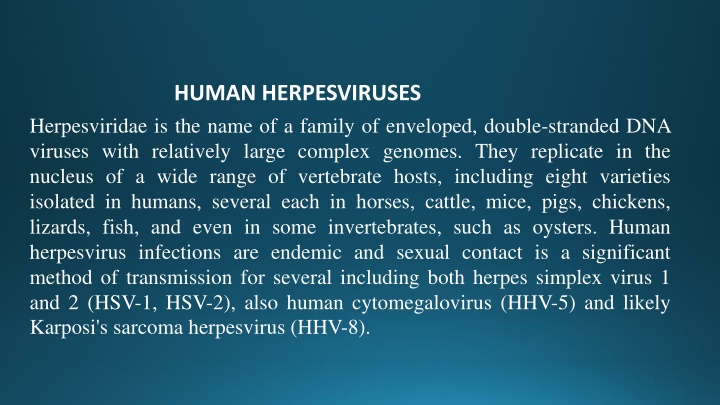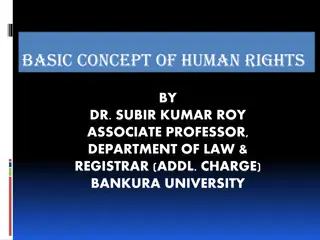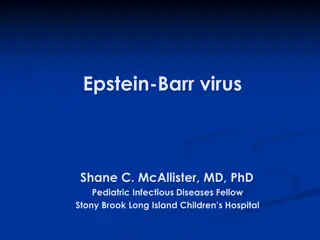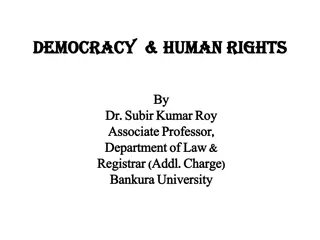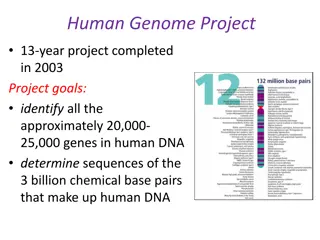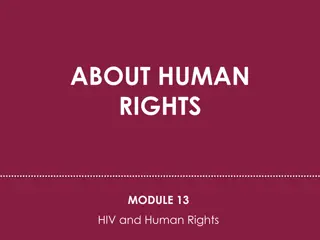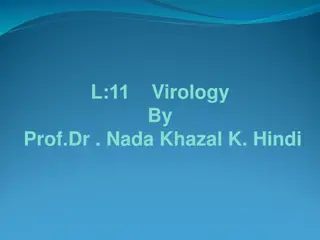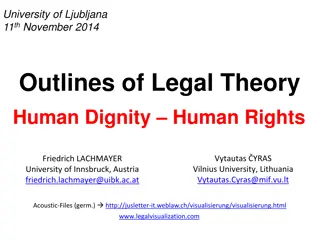Overview of Human Herpesviruses and Their Characteristics
Human herpesviruses, belonging to the Herpesviridae family, are enveloped DNA viruses with complex genomes. They replicate in the host nucleus and have distinct structural elements like the core, capsid, tegument, and envelope. Genome characteristics include a range of 120-230 kbp with terminal repeats. Three subfamilies - Alphaherpesvirinae, Betaherpesvirinae, and Gammaherpesvirinae - exhibit different growth patterns and latency features in various host cells.
Download Presentation

Please find below an Image/Link to download the presentation.
The content on the website is provided AS IS for your information and personal use only. It may not be sold, licensed, or shared on other websites without obtaining consent from the author.If you encounter any issues during the download, it is possible that the publisher has removed the file from their server.
You are allowed to download the files provided on this website for personal or commercial use, subject to the condition that they are used lawfully. All files are the property of their respective owners.
The content on the website is provided AS IS for your information and personal use only. It may not be sold, licensed, or shared on other websites without obtaining consent from the author.
E N D
Presentation Transcript
HUMAN HERPESVIRUSES Herpesviridae is the name of a family of enveloped, double-stranded DNA viruses with relatively large complex genomes. They replicate in the nucleus of a wide range of vertebrate hosts, including eight varieties isolated in humans, several each in horses, cattle, mice, pigs, chickens, lizards, fish, and even in some invertebrates, such as oysters. Human herpesvirus infections are endemic and sexual contact is a significant method of transmission for several including both herpes simplex virus 1 and 2 (HSV-1, HSV-2), also human cytomegalovirus (HHV-5) and likely Karposi's sarcoma herpesvirus (HHV-8).
Virion Structure All herpesvirus virions have four structural elements. Core. The core consists of a single linear molecule of dsDNA in the form of a torus. Capsid. Surrounding the core is an icosahedral capsid with a 100 nm diameter constructed of 162 capsomeres. Tegument. Between the capsid and envelope is an amorphous, sometimes asymmetrical, feature named the tegument. It consists of viral enzymes, some of which are needed to take control of the cell's chemical processes and subvert them to virion production, some of which defend against the host cell's immediate responses, and others for which the function is not yet understood.
Envelope. The envelope is the outer layer of the virion and is composed of altered host membrane and a dozen unique viral glycoproteins. They appear in electron micrographs as short spikes embedded in the envelope.
Genome Characteristics Herpesvirus genomes range in length from 120 to 230 kbp contain 60 to 120 genes. Because replication takes place inside the nucleus, herpesviruses can use both the host's transcription machinery and DNA repair enzymes to support a large genome with complex arrays of genes. All herpesvirus genomes contain lengthy terminal repeats both direct and inverted Simplified Genomic Structure of HCMV, UL: Unique long, US: Unique short, TRL: Terminal repeat long, IRL: Internal repeat long (inverted repeat) of TRL, TRS: Terminal repeat short, IRS: Internal repeat short (inverted repeat) of TRS
Herpesvirus subfamily types Alphaherpesvirinae: are fast- growing, cytolytic viruses that tend to establish latent infections in neurons; HSV (genus Simplexvirus) and varicella-zoster virus (genus Varicellovirus) are members. Herpes simplex virus 1 Human herpesvirus 1 facial, labial and ocular lesions Herpes simplex virus 2 Human herpesvirus 2 genital lesions Varicella-zoster virus Betaherpesvirinae: are slow-growing and may be cytomegalic (massive enlargements of infected cells) and become latent in secretory glands and kidneys; cytomegalovirus (Human herpesvirus 5) is classified in the Cytomegalovirus genus. Also included here, in the genus Roseolovirus, are human herpesviruses 6 and 7. Gammaherpesvirinae: exemplified by EBV (Epstein- Barr Virus): infect and become latent in lymphoid cells. KSHV (Kaposis sarcoma associated herpesvirus) designated as human herpesvirus 8, is classified in the Rhadinovirus genus. Human herpesvirus 3 chickenpox and shingles
Herpes Simplex Viruses There are two distinct HSV: type 1 and type 2 (HSV-1, HSV-2). Their genomes are similar in organization and exhibit substantial sequence homology, initially infect epithelial cells of the oral or genital mucosa. The skin or the cornea. The virus may spread to neurons in which it may be transported to their nuclei. Where it may establish latent infection. HSV-1 commonly infects via the lips or the nose between the age of 6 and 18 months. A latent infection may be reactivated, for example, the host become stressed or immunosuppressed. Reactivation results in the production of virions, which in about 20-40% of cases are transported within the neuron to the initial site of infection in epithelial cells, resulting in a cold sore. Occasionally there may be serious complications such as encephalitis, especially in immunocompromised hosts.
HSV-2 is the usual causative of genital herpes, which is sexually transmitted disease. In new born babies infection can results in serious disease, of mortality rate of about 45%. Although the face and the genital are the normal sites of infection for HSV-1 and HSV-2, respectively, there are increasing numbers of cases where HSV-1 infect the genital and HSV-2 infect the face. REATMENT, PREVENTION, & CONTROL Several antiviral drugs have proved effective against HSV infections, including acyclovir, valacyclovir, and vidarabine. All are inhibitors of viral DNA synthesis.
Varicella-Zoster Virus Infection with varicella zoster virus usually occurs in childhood and causes varicella (chickenpox), when the virus spreads through the blood to the skin, causing a rash. It may also spread to nerve cells, where it may establish a latent infection. The nerves most often affected are those in the face or the trunk, and these are the areas most commonly affected in zoster (shingles) when a latent infection is reactivated. TREATMENT Several antiviral compounds provide effective therapy for varicella, including acyclovir, valacyclovir, famciclovir, and foscarnet. The zoster vaccine is recommended for those with chronic medical conditions and for persons over 60 years of age.
Human cytomegalovirus In the vast majority of infections with human cytomegalovirus, symptoms are either absent or they are mild. In a pregnant women, however, the virus can infect the placenta and then the fetus, for whom the consequences may be serious. In one study it was estimated that 0.7% of children are born infected with virus. In some of these there is evidence of virus-induced damage, including small brain size and enlargement of the liver and spleen: 0.5% of these congenitally infected babies die. Up to 20%of the survivors develop problems, include hearing loss and mental retardation.
Human cytomegalovirus can also cause sever disease e.g( pneumonits, hepititis)in immunocompromised patients such as those with AIDS, those who have received treatment for cancer, and those who are immunosuppressed because they have received organ transplant. TREATMENT&CONTROL Ganciclovir, valganciclovir, cidofovir and foscarnet have all been approved by the FDA for the treatment of specific diseases resulting from CMV infection in immunosuppressed patients Progression of CMV retinitis may be delayed in the short term by intravenous ganciclovir or foscarnet. Both are equally effective; however, foscarnet is not as well tolerated. Acyclovir is not effective for CMV infections A vaccine is currently under development
Mechanisms of antivirals action against CMV(Cherrington et al., 1998)
Mutation associated with viral resistance to CMV (Cherrington et al., 1998)
Human herpesvirus 6 There are two types of human herpesvirus 6, known as HHV-6A and HHV- 6B. Infection of a child with the latter can cause a fever and the sudden appearance of a rash known as exanthema subitum Human herpes virus 7 The virus has been associated with some cases of exanthema subitum.
Epstein- Barr Virus(human herpes virus type 4) Epistein- barr virus (EBV) is transmitted in saliva. Epithelial cells are infected first then the infection spreads to B cells which are the main host cell type for this virus. More than 90% of people become infected with EBV, usually during the first years of life, when infection results in few or no symptoms. In developed countries some individuals do not become infected until adolescent or adulthood. Commonly called the (kissing disease) by doctors, EBV is associated with a number of tumors in humans. PREVENTION, TREATMENT, & CONTROL There Acyclovir reduces EBV shedding from the oropharynx during the period of drug administration. is no EBV vaccine available.
Kaposis sarcoma associated herpesvirus Kaposis sarcoma associated herpesviruswas discovered in 1994.( most often seen in people with HIV). Treatment of KSHV Oral Lesions Large intraoral lesions of KS can be treated with systemic chemotherapeutic single-agents such as vinblastine and vincristine. Small intraoral lesions can be treated with surgical and laser excision. Nonsurgical treatment is also effective, such as intralesional injections of vinblastine sulfate.
herpesvirus replication The most extensive research on herpesviral replication has been done on HSV. It is believed that other herpesviruses follow similar pathways, with some at slower paces than others. (1) HSV virion attaches to host cell with the envelope glycoprotein. (2) The viral envelope fuses to the plasma membrane in a pH-independent fashion such that the nucleocapsid enters the cytoplasm. (3) The capsid travels along the cytoskeleton to a nuclear pore where the viral DNA is released. The linear genome enters the nucleus and circularizes.
(4) Once in the nucleus, the viral DNA is transcribed into mRNA by cellular RNA polymeraseII. (5) After transcription in the nucleus, all mRNA transcripts are translated into protein in the cytoplasm. Subsequently, the proteins can go to the nucleus, stay in the cytoplasm, or become a part of the membrane bilayer. (6) Capsid proteins assemble in the nucleus to form empty capsids. (7) Full-length viral DNA is packaged to form nucleocapsids. (8) The nucleocapsids associate with segments of the nuclear membrane where tegument and glycosylated envelope proteins have bound. This association triggers envelopement by budding through the nuclear membrane.
9) Enveloped virions accumulate in the endoplasmic reticulum (ER). (10) Mature virions are released by exocytosis. (11) Virus-specific proteins are also found on the plasma membrane of infected cells.
Entry of HSV into the host cell involves interactions of several glycoproteins on the surface of the enveloped virus, with receptors on the surface of the host cell. The envelope covering the virus particle, when bound to specific receptors on the cell surface, will fuse with the host cell membrane and create an opening, or pore, through which the virus enters the host cell. An enzyme shuts off protein synthesis in the host, degrades host mRNA, helps in viral replication, and regulates gene expression of viral proteins.
